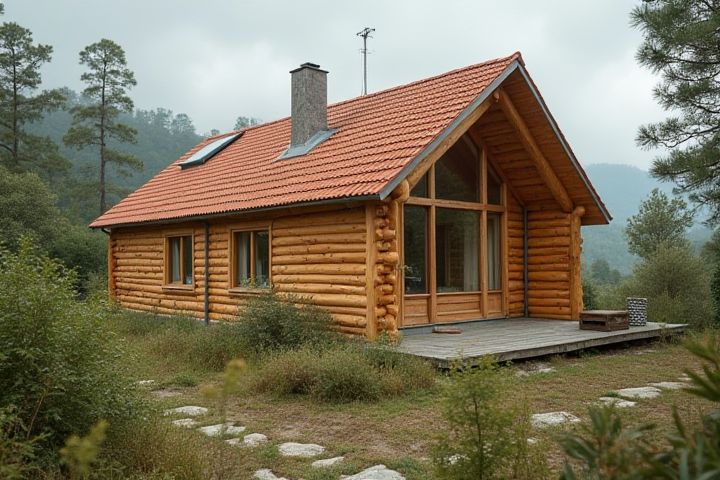
To build a house sustainably, prioritize eco-friendly materials such as bamboo, recycled steel, or reclaimed wood. Incorporate energy-efficient systems, like solar panels and high-efficiency HVAC units, to reduce your carbon footprint. Ensure proper insulation with materials such as cellulose or sheep's wool, which help maintain temperature and minimize energy consumption. Design the home to maximize natural light, reducing the need for artificial lighting and enhancing the indoor environment. Implement rainwater harvesting and greywater recycling systems to conserve water and promote resource efficiency in your household.
How To Build A House Sustainably
Use eco-friendly building materials
Using eco-friendly building materials is essential for sustainable construction, reducing environmental impact while promoting health and efficiency. Opt for recycled or reclaimed materials, like reclaimed wood, which not only lowers waste but also adds character to your home. Incorporating bamboo, a rapidly renewable resource, can provide durable flooring and cabinetry, while insulating with cellulose, made from recycled paper, enhances energy efficiency. Your choice of low-VOC paints and finishes can improve indoor air quality, ensuring a healthier living environment for you and your family.
Incorporate renewable energy sources
Incorporating renewable energy sources is crucial for sustainable house construction. Consider installing solar panels, which can generate an average of 300 watts per panel, significantly reducing your reliance on traditional energy. Wind turbines, especially in areas with consistent wind speeds of 12 mph or higher, can also provide supplementary energy, potentially covering up to 70% of your annual energy needs. Implementing energy-efficient systems, such as geothermal heating and cooling, can lower your energy consumption by about 30-60%, further contributing to a sustainable living environment.
Implement water-saving techniques
Implementing water-saving techniques for sustainable house construction can significantly reduce your environmental footprint. Installing low-flow fixtures such as showerheads and faucets can decrease water usage by up to 30%, while dual-flush toilets can save an average of 1.6 gallons per flush. Rainwater harvesting systems allow you to collect and use rainwater for irrigation or non-potable applications, potentially saving thousands of gallons annually. Incorporating drought-resistant landscaping can further minimize water needs, promoting a healthier ecosystem and reducing reliance on municipal water sources.
Design for passive heating and cooling
To build a house sustainably, focus on design strategies that optimize passive heating and cooling, which can reduce energy consumption significantly. Utilize south-facing windows to maximize solar gain during winter, while strategically placing overhangs to shield interior spaces from direct sunlight in the summer. Insulation plays a critical role; materials with a high R-value can enhance thermal performance, ensuring a comfortable indoor environment throughout the year. Orienting your home to capture prevailing winds can promote natural ventilation, further decreasing reliance on mechanical cooling systems.
Optimize energy efficiency
To build a house sustainably and optimize energy efficiency, incorporate high-performance insulation materials such as spray foam or cellulose, which can reduce heat loss by up to 30%. Install energy-efficient windows with low-E coatings to minimize thermal transfer and enhance natural light without compromising R-values; aim for a U-factor below 0.30 for optimal performance. Utilize renewable energy sources, like solar panels that can generate upwards of 10,000 kWh annually, significantly decreasing reliance on fossil fuels. Employ smart home technology, such as programmable thermostats, which can save you up to 10% on heating and cooling costs, ensuring your home remains energy-efficient year-round.
Ensure proper insulation
Ensure proper insulation in your sustainable house by selecting high-quality, eco-friendly materials that minimize energy loss. Use options like cellulose, sheep's wool, or recycled denim, which provide excellent thermal resistance while reducing environmental impact. Pay particular attention to sealing gaps and cracks, as proper air sealing enhances insulation performance and decreases heating and cooling costs. Incorporating renewable energy sources, like solar panels, can further complement your well-insulated home, leading to a significant reduction in your overall carbon footprint.
Choose sustainable landscaping
Sustainable landscaping involves selecting native plants that require minimal water and maintenance, enhancing local biodiversity. Incorporating permeable surfaces aids in proper drainage and reduces stormwater runoff, promoting ecological balance. Utilizing organic mulch not only conserves moisture but also enriches the soil over time. Consider installing rain gardens to capture runoff and filter contaminants, ensuring a healthier environment around your sustainable home.
Plan for waste reduction and recycling
To build a house sustainably, prioritize waste reduction by carefully planning your construction processes. Implement a take-back program with your suppliers to recycle materials such as wood, metal, or concrete. Consider using prefabricated components, which can minimize on-site waste by up to 20%, allowing for better resource management. Incorporating a dedicated recycling area on-site ensures that materials are sorted and processed efficiently, contributing to a circular economy approach in your housing project.
Utilize low-VOC paints and finishes
Utilizing low-VOC (volatile organic compounds) paints and finishes is essential for creating a sustainable home environment, as these products significantly reduce indoor air pollution. When building your house, opt for brands that offer certified low-VOC or zero-VOC options, which can contain up to 95% fewer harmful chemicals compared to standard paints. Incorporating these eco-friendly finishes not only improves air quality but also promotes a healthier living space for you and your family. Remember to check for credible certifications and labels, like Green Seal or Greenguard, to ensure the sustainability and safety of the materials you choose.
Consider the home's lifecycle impact
When building a house sustainably, focus on minimizing its lifecycle impact, which includes materials, energy consumption, and waste management. Opt for renewable materials, such as bamboo or recycled steel, that reduce environmental strain and promote sustainability. Incorporating energy-efficient systems like solar panels can decrease operational costs, with estimates suggesting up to 30% savings on energy bills. Moreover, consider water-saving fixtures and greywater systems that can reduce water usage by approximately 50%, contributing to a more sustainable home throughout its lifespan.
